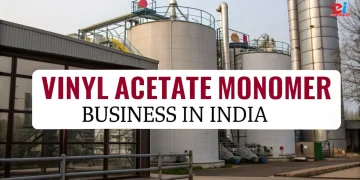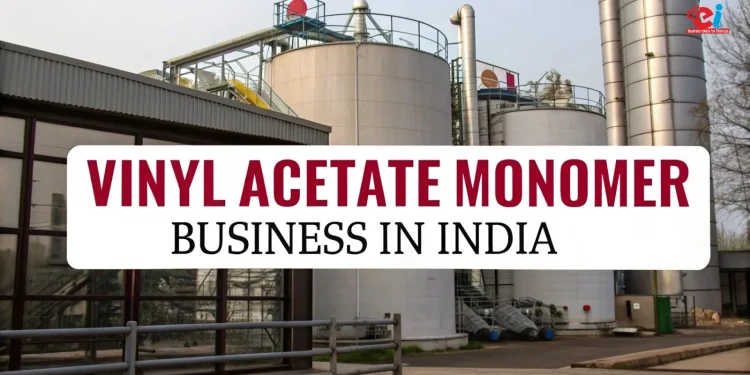A New Frontier for Chemical Entrepreneurs
VAM, or Vinyl Acetate Monomer, is quickly becoming one of the most in-demand chemicals in India. It is important for several industries as it serves as an adhesive, paint, coating, and even a pharmaceutical intermediate. With the advent of the “Make in India” initiative and increased self-reliance for critical components like Active Pharmaceutical Ingredients (APIs), there is now a need for strategic investment into VAM production facilities.
In this article, we shall explore everything an entrepreneur or new startup would need to know prior to starting their VAM business in India. This includes but is not limited to: market conditions, manufacturing processes, startup costs, value estimates and profits – all with real-world data on setting up a vinyl acetate monomer plant.
1. Introduction to Vinyl Acetate Monomer and Its Uses
Like many other organic compounds, Vinyl Acetate Monomer has a unique chemical formula which is CH₃COOCH=CH₂. Indeed, it has a colorless appearance and organoleptic characteristics like sweet-smelling fragrances. Also, it assists greatly in the production of many polymers.
Almost all branches — polyvinyl acetate (used in adhesives and binders), hyper-branched polyvinyl alcohols (used in textiles, paper, and also in pharmaceutical industries), and ethylene-vinyl acetate (utilized for packaging films as well as solar panels) — showcase the extensive range of uses of this compound.
Most importantly, VAM in pharmaceuticals is used for synthesis of intermediates for several APIs.
This further means that with the growing Indian pharma companies, ever so gradually this demand will constantly grow with its domestic peers too, thus making VAM essential to all industrial chemicals and enabling entrepreneurs to broaden their horizons towards healthcare manufacturing too.
2. Investment Opportunities and Trends in India
India is currently experiencing a growth spurt in its VAM market. While global projections estimate the VAM market to grow from around USD 8.6 billion in 2024 to over USD 11.5 billion by 2030, there are even bolder forecasts for the Indian market.
Traditionally, India has been heavily dependent on imports to fulfill its VAM needs, sourcing large quantities from China, Saudi Arabia, and South Korea. However, rising supply chain concerns coupled with the government’s push towards Atmanirbhar Bharat (self-reliance) in chemicals and pharmaceuticals is changing this narrative fast.
Due to initiatives like Production Linked Incentive (PLI) schemes for the pharma and chemical sectors and PCPIRs’ infrastructure development, this change is possible. PCPIRs offer pre-zoned regulatory-compliant land for chemical units along with utilities, logistics infrastructure, and workforce — increasing accessibility for new investors and significantly lowering entry barriers.
Another vital driver comprises India’s middle class, urban infrastructure, and consumer durables sector, which constantly feeds the requirements of sealants, paints, coatings, and packaging. All these sectors utilize polymers from VAM, which ensures there is always a strong and steady demand for any new manufacturer entering the market.
Related: Production of Ethyl Acetate as a Growing Business
3. Take A Tour With Us: The Manufacturing Process
The process of manufacturing vinyl acetate monomer involves well-established chemical reactions that are efficient, easy to scale, and tech-savvy. One common method employs vapor-phase oxidation with ethylene, acetic acid, and oxygen, using a palladium-based catalyst. While this method does streamline processes, it requires precise engineering and safety control because flammable gases and catalysts are used.
Fusing together ethylene gas, glacial acetic acid, and oxygen (derived from compressed air or pure oxygen feed) starts the process. A palladium-gold catalyst supported on silica is used in a tubular reactor. The mixed reactants are pre-heated and then placed into the reactor where optimal conditions enable the catalytic reaction to transform ethylene along with acetic acid into vinyl acetate alongside water as a byproduct.
Any non-reacted gases along with the product undergo multiple condensers for partial separation of crude vinyl acetate.
Once the vinyl has been separated, it undergoes further processes to ensure that all impurities are eliminated using distillation, thus enhancing its stability for easier storage and transportation. This step is crucial since VAM is reactive and volatile. Therefore, safety systems like scrubbers, lean stream flare stacks, and emergency shutdown systems that deal with containment emissions must be fitted.
When entrepreneurs are establishing new plants, they should seek out partners that offer complete solutions — starting with designs and catalysts, all through to vent control and operator education, which aids in emissions after operational procedures are done.
4. Setting Up the Plant: Investment and Cost Breakdown
Setting up a vinyl acetate monomer plant is an expensive project. It requires significant investment towards land, equipment, infrastructure such as utilities, and acquiring necessary permits or licenses.
Nonetheless, these plants operate at high capacity utilization and generate stable long-term returns because of their sustained demand across several industries.
For a medium-scale plant with an annual capacity of around 10,000 to 15,000 tonnes, the estimated initial investment is between ₹40 to ₹50 crores.
- Land Cost (Industrial zone/PCPIR): ₹3 to ₹5 crores
- Civil Construction & Admin Buildings: ₹5 to ₹6 crores
Subtotal: ~₹8 crore - Plant & Machinery (reactor, distillation, vessels, automation): ₹18 to ₹22 crores
- Pollution Control & Safety Systems (boilers, towers, fire systems): ₹4 to ₹5 crores
- Pre-operative Costs (approvals, consultation, design, training): ₹2 crores
- Working Capital (raw material, utilities, staffing): ₹8 to ₹10 crores
Although this amount may seem overwhelming at first glance, it can be mitigated by effective project planning, government grants, and contracts with purchasers.
5. Profitability Outlook and Business Potential
For skilled entrepreneurs able to manage input costs effectively and operational cost efficiencies well, the production of vinyl acetate monomers offers attractive margins.
Two of the essential raw materials—ethylene and acetic acid—are domestically sourced; therefore, strategic supply agreements can secure profitability through price locking.
The demand for VAM’s end-products is almost recession-proof across packaging, adhesives, and pharmaceutical industries. This allows for reliable cash flow post plant operations commencement.
For most medium-sized VAM plants, break-even is achieved within 3 to 4 years, provided output levels and market conditions are stable.
Additionally, entrepreneurs might consider downstream integration by manufacturing polymers based on VAM like EVA or PVA, which provides a chance at higher-margin niche segments such as solar energy, bio-degradable films, or medical-grade adhesives.
6. Compliance and Safety Regulations Navigating
Everything to do with compliance when running a VAM plant is regulatory.
Entrepreneurs need:
- MoEFCC clearance
- State Pollution Control Board (SPCB) consent
- Adherence to hazardous waste management guidelines
Installation of emission control systems and observing effluent discharge norms is mandatory.
Additionally, fire and safety licenses are required due to flammable ethylene and oxygen used in the process. Hiring certified environmental engineers or safety consultants helps avoid complications down the line, which aids operations.
Related: Top 20 Chemical Manufacturing Ideas for Startups
How NPCS Can Help You Start Your VAM Plant
Niir Project Consultancy Services (NPCS) offers end-to-end support for entrepreneurs planning to venture into the vinyl acetate monomer business. NPCS specializes in preparing Market Survey cum Detailed Techno-Economic Feasibility Reports (TEFR) that help de-risk your investment by giving a 360-degree view of the business opportunity.
Each report covers vital aspects such as manufacturing process flowcharts, raw material requirements, machinery specifications, plant layout, and detailed financials including break-even and ROI analysis. Entrepreneurs working with NPCS also gain access to reliable vendor networks, compliance checklists, and operational insights that can accelerate their time-to-market.
By partnering with NPCS, entrepreneurs can transform a high-capital project into a manageable, bankable business venture that aligns with India’s growing industrial demand.
Conclusion: A Smart Bet in India’s Chemical Future
The vinyl acetate monomer business represents a confluence of opportunity, demand, and policy support. For entrepreneurs with a strong interest in chemicals, pharmaceuticals, and industrial raw materials, VAM is not just another product—it is a portal to multiple downstream opportunities with stable cash flows.
With demand rising across the pharmaceuticals, packaging, paints, and adhesive sectors, and with India’s import dependence continuing to be a bottleneck, there has never been a better time to localize VAM production. While capital requirements are high, so too are the long-term returns—especially when the venture is backed by a solid feasibility plan, expert technical support, and a sharp eye on operational excellence.
Whether you’re a first-time industrial entrepreneur or an established pharma stakeholder looking to integrate upstream, the vinyl acetate monomer market in India is a smart bet—and a timely one.
Looking to start your own VAM manufacturing unit?
Explore detailed feasibility reports from Niir Project Consultancy Services (NPCS) to make informed, confident decisions.
Visit www.niir.org for ready-to-download reports on hundreds of chemical and pharma-related projects.


























